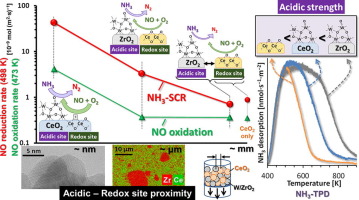Journal of Catalysis ( IF 7.3 ) Pub Date : 2018-02-03 , DOI: 10.1016/j.jcat.2017.12.032 Masaoki Iwasaki , Kazuhiko Dohmae , Yasutaka Nagai , Eiichi Sudo , Toshiyuki Tanaka

|
A bifunctional pathway for selective catalytic reduction (SCR) with NH3 was established using a mixture of WO3/ZrO2 possessing strong acidity and CeO2 possessing moderate redox activity. The physical mixture (tight contact) of WO3/ZrO2 (4.2 W/nm2) and CeO2 provided enhanced SCR reactivity but did not improve the redox property assessed by NO oxidation. No improvement of the SCR conversion, however, was observed for mixtures of individual pellets (loose contact), suggesting the requirement of submicrometer-level proximity of the acidic sites to the redox centers. WO3/CeO2 (5.3 W/nm2) with intermediate acidic strength had higher SCR and NO oxidation rates than the aforementioned physical mixture of WO3/ZrO2 and CeO2. The weakly basic sites (OH species) on CeO2 were replaced stoichiometrically with strongly acidic sites on the WO3 domains along with an increase in the W density (0–24.4 W/nm2), and monoclinic WO3 crystallites then formed at approximately 10 W/nm2. The dispersed WO3 was in a distorted octahedral environment in all WO3/CeO2 samples. The intrinsic SCR reactivity was controlled by only the W surface density; the SCR rate (per surface area) increased within the polytungstate submonolayer region (<5–10 W/nm2) and then nearly reached a plateau. The NO oxidation rate also increased with an increase of the W density in a similar trend to the SCR rate, which is indicative of the formation of redox-active centers, rendering the synergetic enhancement of SCR reactivity. These findings and conclusions reached here provide useful guidance for new bifunctional strategies to achieve practical SCR performance.
中文翻译:

双功能NH 3 -SCR途径以及分散在CeO 2催化剂上的WO 3的结构和酸碱性质的实验评估
使用具有强酸性的WO 3 / ZrO 2和具有中等氧化还原活性的CeO 2的混合物,建立了用NH 3进行选择性催化还原(SCR)的双功能途径。WO 3 / ZrO 2(4.2 W / nm 2)和CeO 2的物理混合物(紧密接触)提供了增强的SCR反应性,但没有改善通过NO氧化评估的氧化还原特性。但是,对于单个颗粒的混合物(松散接触),未观察到SCR转化率的改善,这表明要求酸性位点与氧化还原中心的亚微米级接近性。WO 3 / CeO 2(5.3 W /纳米2)具有中等酸性强度,比上述的WO 3 / ZrO 2和CeO 2物理混合物具有更高的SCR和NO氧化速率。CeO 2上的弱碱性位点(OH物种)在化学计量上被WO 3结构域上的强酸性位点取代,同时W密度增加(0-24.4 W / nm 2),然后单斜晶WO 3晶体形成10 W / nm 2。在所有WO 3 / CeO 2中,分散的WO 3处于扭曲的八面体环境中样品。固有的SCR反应性仅受W表面密度的控制。SCR速率(每表面积)在多钨酸盐亚单层区域(<5-10 W / nm 2)内增加,然后几乎达到平稳状态。NO氧化速率也随着W密度的增加而增加,其趋势与SCR速率相似,这表明氧化还原活性中心的形成,从而使SCR反应性协同增强。此处获得的这些发现和结论为实现实际SCR性能的新双功能策略提供了有用的指导。



























 京公网安备 11010802027423号
京公网安备 11010802027423号